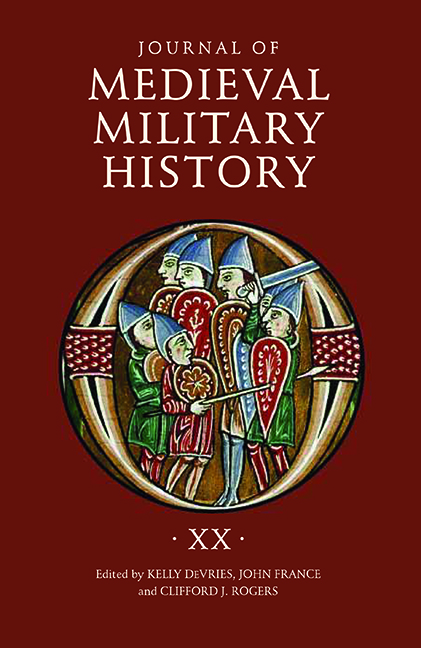Book contents
- Frontmatter
- Contents
- List of Illustrations
- 1 De velitatione bellica and the Georgian Art of War During the Reign of David IV
- 2 The Afterlife of the Medieval Christian Warrior
- 3 More Accurate Than You Think: Re-evaluating Medieval Warfare in Film
- 4 Raising the Medieval Trebuchet: Assembly Method and the Standing of a Half-scale Machine
- 5 Cum Socio Eiusdem: Military Recruitment in the Armies of Edward I Among the Sub-Gentry
- 6 Two Walls of Protection: Queen Elionor of Sicily and Bishop Berenguer de Cruïlles of Gerona During the 1359 Naval Campaigns of The War of the Two Pedros
- 7 The Lancegay and Associated Weapons
- 8 “I intend to give him battle.” Battle-Seeking in a Civil War Context: Toro (1476)
- 9 Discovery of an Early Sixteenth-Century Battle Plan from the Archdiocesan Archive in Ljubljana
- List of Contributors
- Journal of Medieval Military History 1477-545X
5 - Cum Socio Eiusdem: Military Recruitment in the Armies of Edward I Among the Sub-Gentry
Published online by Cambridge University Press: 07 October 2022
- Frontmatter
- Contents
- List of Illustrations
- 1 De velitatione bellica and the Georgian Art of War During the Reign of David IV
- 2 The Afterlife of the Medieval Christian Warrior
- 3 More Accurate Than You Think: Re-evaluating Medieval Warfare in Film
- 4 Raising the Medieval Trebuchet: Assembly Method and the Standing of a Half-scale Machine
- 5 Cum Socio Eiusdem: Military Recruitment in the Armies of Edward I Among the Sub-Gentry
- 6 Two Walls of Protection: Queen Elionor of Sicily and Bishop Berenguer de Cruïlles of Gerona During the 1359 Naval Campaigns of The War of the Two Pedros
- 7 The Lancegay and Associated Weapons
- 8 “I intend to give him battle.” Battle-Seeking in a Civil War Context: Toro (1476)
- 9 Discovery of an Early Sixteenth-Century Battle Plan from the Archdiocesan Archive in Ljubljana
- List of Contributors
- Journal of Medieval Military History 1477-545X
Summary
Following the pathbreaking work of Andrew Ayton, scholars have developed sophisticated methods for analyzing the relationships among members of the knightly class and gentry to demonstrate the existence of “military communities” that joined together to form the English armies of the Hundred Years’ War. More recently, scholars have used these same techniques to identify similar military communities among the knights and gentry during the reigns of Edward I and Edward II. The main sources for establishing these ties of family, tenancy, friendship, and previous military service have been the so-called “horse lists”, which were essentially insurance records for the mounts of men in the army, and letters of protection, guaranteeing freedom from prosecution and debt collection while the combatant was in royal service. Knights and members of the gentry appear quite frequently in these types of documents. However, 90% or more of the men in the English armies during the reign of Edward I, belonging to the economic and social strata below the gentry, rarely appear in either letters of protection or horse lists. As a result, these men have not received any attention from the perspective of analyzing English military communities in the thirteenth and early fourteenth centuries. Through a systematic analysis of broad classes of largely unpublished documents from Edward I's military campaigns in Scotland between 1296–1307, particularly payroll and victualling documents as well as garrison rolls, this essay begins to address the scholarly lacunae with respect to sub-gentry soldiers and finds that they also formed military communities in the same ways as their social and economic superiors.
Prosopographical studies of the fighting men serving in the English armies during the Hundred Years’ War, largely drawing on the models developed by Andrew Ayton, have focused extensively on the question of recruitment networks among the knightly class and gentry. More recently, this social-prosopographical approach has been adopted with respect to the reign of Edward I (1272–1307) in the later thirteenth and early fourteenth centuries, most notably by David Simpkin and Andrew Spencer. As has been true of the treatment of military recruitment from the reign of Edward III (1327–77) to that of Henry V (1413–22), the prosopographical examination of the armies of Edward I tends to draw extensively on horse inventories and to a more limited extent, royal letters of protection.
- Type
- Chapter
- Information
- Journal of Medieval Military HistoryVolume XX, pp. 109 - 124Publisher: Boydell & BrewerPrint publication year: 2022



